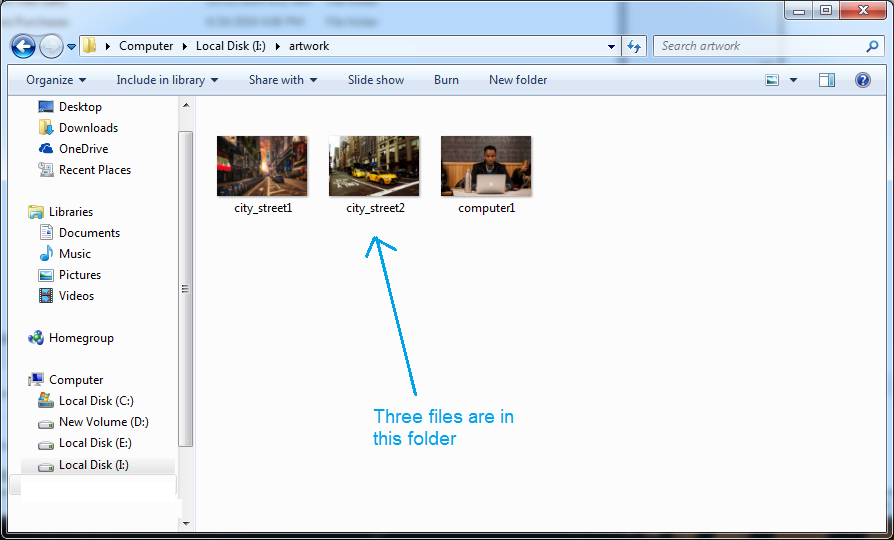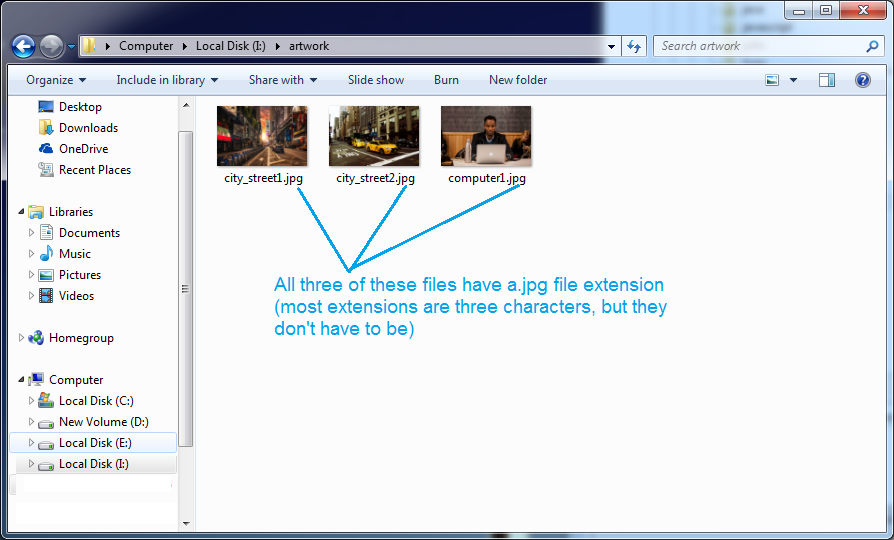File Management
File management skills are very important to software development and programming, especially web development. These tutorials emphasize file management concept and skills in the Microsoft Windows environment, but they are equally important in any operating system (e.g. Mac, Linux, etc.).
Part 1: In this Part 1 tutorial will cover:
- Drive Letters
- Sub-folders
- File extensions
- How to view file extensions
- Paths
- Keyboard shortcuts
Drive Letters
The first thing one should be familiar with is drive letters. Common drive letters include:
C: D: E: etc.
The C: drive is typically a computer's primary hard drive. D: is often a DVD-drive. E: might by a USB thumb drive, if plugged in. The purpose of the C: drive likely seldom changes, but the other drive letters can if one has more than one disk or a hard disk partitioned into several drive letters. We will assume you are using your C: drive as your primary hard drive to store your data files.
If you press and hold the Windows key and press E (Win-E) you can bring up the Computer window which will show you - and let you navigate into - all your computer drives. This is an very useful utility of file management in Windows. The screenshot below shows an example. This computer has the two hard drives split into the C: D: E: and I: drive letters.

Sub-Folders
If you double-click on a drive, such as I, you will be taken to the root directory/folder of the I: drive. An example of this is in the image below.

Next, I will double-click on the artwork folder to drill down into it.

Viewing File Extensions
An important skill to have is how to view (turn on) file extensions. Most computer files have a file extension. THe file extension indicates what type of file it is. In the image above, file extensions are not visible (this is the default view in current versions of Windows). To turn on viewing of file extensions in Windows 7, you do the following:
- Click Organize
- Click Folder and Search Options
- Click View Tab
- Un-check box "Hide extensions for known file types"

In Windows 10, you turn on viewing of file extensions by clicking open the File Explorer (Win-E), click View, then click "File name extensions" (easier in Windows 10).

Here is our folder with the file extensions turned on for viewing.

It is worthwhile to note that the full path to the first of these three files is:
i:\artwork\city_street1.jpg
Below is an list and description of some of the well-known file extentsions and their associated uses (there are hundreds more). ASCII files are, in essence, text-only files meaning they can be opened, their contents viewed, and edited with a pure text editor such as notepad or Notepad++. Binary files cannot be viewed or edited with a pure text editor as they contain more than pure text. Binary files are created with software programs such as Microsoft Word, Adobe Photoshop, video or audio capture software, etc. They can contain content in many formats, e.g. text, various fonts and formatting, audio, video, animation, etc. Moft file formats are binary. Programmers and IT professionals use ASCII files more than than non-IT professionals.
| File Extension | Use | Type |
|---|---|---|
| .html | HTML web pages | ASCII |
| .jpg or .jpeg | Image format that supports 16.7 million colors | Binary |
| .docx or .doc | Microsoft Word file | Binary |
| .mp3 | Popular music audio format | Binary |
| .png | Popular image format, especially for web pages | Binary |
| .xlsx or .xls | Microsoft Excel format | Binary |
| .zip | Compressed zip file (contains files and folders within it) | Binary |
| .exe | Executable file | Binary |
| .py | Source file of Python program/programming language | ASCII |
| .csv | Comma delimited text file (Comma Seperated Values) | ASCII |
| .svg | Image format; Scalable Vector Graphic | ASCII |
| .php | Source file of PHP program/programming language; For dynamic web pages | ASCII |
| .wmv | Video format (with Audio) | Binary |
File Paths
| Path Example | Description | Type |
|---|---|---|
| d:\web_files\index.html | The path to a web page file named index.html stored in the sub-folder web_files on the computer's D: drive. Absolute addresses should not be used in web pages for links to internal files (within the same domain name) Absolute addresses should be used for . | Absolute path (address) |
| d:\web_files\images\logo.png | The path to an image file located two sub-folders deep on the d: drive. | Absolute path (address) |
| images/logo.png | The path to an image located in an images folder which is a sub-folder (child) to the current folder (where the .html or .php is located). Relative addresses should be used in web pages. | Relative path (address) |
| images/clients/jsmith.png | The path to an image located in two sub-folders below the current folder (where the .html or .php is located). | Relative path (address) |
| ../customers.php | The path to a PHP web page (customers.php) located one folder higher (the parent) than the current folder (where the html page is). | Relative path (address) |
| ../../customers.php | The path to a PHP web page (customers.php) located two folders higher (grantparent) than the current folder (where the html page is). | Relative path (address) |
| ../../images/customers.php | The path to a PHP web page (customers.php) located two folder higher (grantparent) than the current folder (where the html page is) and then one folder down (child/sub-folder), i.e. up two folders, down one folder. | Relative path (address) |
| /images/customers.php | The path to an image file located in the images folder that is a sub-folder off the root folder. | Relative path (address) |
Keyboard shortcuts
Microsoft Windows keyboard shortcuts
- Alt-Tab - Switch between open programs/applications
- Win-Tab - Switch between open programs/applications
- Alt-F4 - Close/quit an applications
- F5 - Refresh screen
- F1 - Help
Windows Software/Program Keyboard Shortcuts (e.g. Microsoft Office, web browsers, editors, etc.)
- F2 - Rename (file or folder)
- F5 - Refresh
- Ctrl-C - Copy
- Ctrl-V - Paste
- Ctrl-X - Cut
- Ctrl-Z - Undo
- Ctrl-A - Select All text/items
- Ctrl-F - Find
- Ctrl-G - Go to a specific page or line number
- Ctrl-S - Save
- Ctrl-P - Print
Navigating and Selecting Text in Windows Applications with the Keyboard
- Home key - Move cursor to beginning of line
- End key - Move cursor to end of line
- Ctrl-Home - Move cursor to beginning of document
- Ctrl-End - Move cursor to end of document
- Ctrl-Right - Arrow Move cursor one word to the right
- Ctrl-Left - Arrow Move cursor one word to the left
- Ctrl-Down - Arrow Move cursor down to next paragraph
- Ctrl-Up - Arrow Move cursor up to previous paragraph
- Shift-Home key - Highlight text from current position to beginning of line
- Shift-End key - Highlight text from current position to end of line
- Ctrl-Shift-Right Arrow - Highlight text from current position to next word to the right
- Ctrl-Shift-Left Arrow - Highlight text from current position to next word to the left
- Double left-click a word - Highlight/select a word
- Triple left-click a word - Highlight/select the paragraph